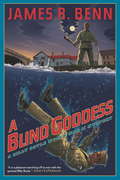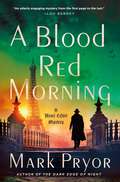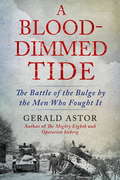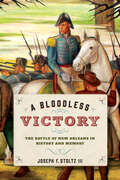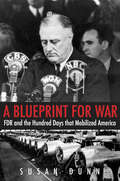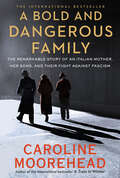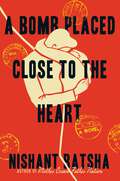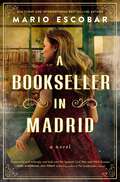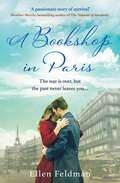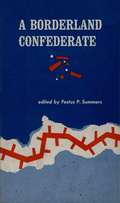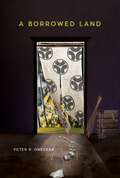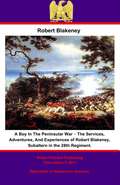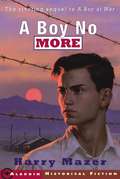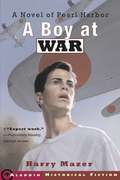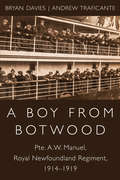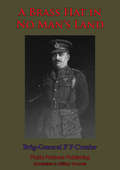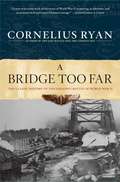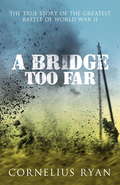- Table View
- List View
A Blind Goddess (A\billy Boyle Wwii Mystery Ser. #8)
by James R. BennMarch, 1944: US Army Lieutenant Billy Boyle, back in England after a dangerous mission in Italy, is due for a little R&R, and also a promotion. But the now-Captain Boyle doesn't get to kick back and enjoy his leisure time because two upsetting cases fall into his lap at once. The first is a personal request from an estranged friend: Sergeant Eugene "Tree" Jackson, who grew up with Billy in Boston, is part of the 617th Tank Destroyers, the all-African American battalion poised to make history by being the US Army's first combatant African American company. But making history isn't easy, and the 617 faces racism at every turn. One of Tree's men, a gunner named Angry Smith, has been arrested for a crime he almost certainly didn't commit, and faces the gallows if the real killer isn't found. Tree knows US top brass won't care about justice in this instance, and asks Billy if he'll look into it.But Billy can't use any of his leave to investigate, because British intelligence agent Major Cosgrove puts him on a bizarre and delicate case. A British accountant has been murdered in an English village, and he may or may not have had some connection with the US Army--Billy doesn't know, because Cosgrove won't tell him. Billy is supposed to go into the village and investigate the murder, but everything seems fishy--he's not allowed to interrogate certain key witnesses, and his friends and helpers keep being whisked away. Billy is confused about whether Cosgrove even wants him to solve the murder, and why. The good news is the mysterious murder gives Billy an excuse to spend time in and around the village where Tree and his unit are stationed. If he's lucky, maybe he can get to the bottom of both mysteries--and save more than one innocent life.From the Hardcover edition.
A Blood Red Morning: A Henri Lefort Mystery (Henri Lefort Mysteries #3)
by Mark PryorIn this unputdownable WWII series, Paris detective Henri Lefort, must solve a complex case when a man is murdered on the policeman's own doorstep.January 1941: It's cold and still dark when Paris Detective Henri Lefort wakes up to an empty apartment, irritated with his roommate for not even starting the coffee.Irritation turns to suspicion when he starts his walk to work and spots a large blood stain in front of the building. At the office his boss, chief of homicide, is incredulous that Henri didn't hear the gunshot that killed a man right outside his apartment. On the plus side, this means that Henri isn't a witness and can investigate the case.It first appears that the dead man is a nobody—but Henri soon finds out he's a nobody with a classified police file. Henri confronts his bosses and then the Germans, but is stonewalled. So he turns his investigation to the other tenants in his building. Coincidentally, each resident claims ignorance. When Henri learns that the dead man was a German agent, he must face the real possibility that one of his friends and neighbors is a killer. It's his job to find the truth no matter what, but when he does he faces the biggest dilemma of his career—whether in times like these the rules of justice should be, just sometimes, trumped by the rules of war.
A Blood-Dimmed Tide: The Battle of the Bulge by the Men Who Fought It
by Gerald AstorDrawing on firsthand accounts by survivors of the bloody Battle of the Bulge, diaries, letters, and official documents, this study describes the events of the campaign, hardships faced by the soldiers, the battle's horrifying costs, and the controversy surrounding the campaign.
A Bloodless Victory: The Battle of New Orleans in History and Memory (Johns Hopkins Books On The War Of 1812 Ser.)
by Joseph F. Stoltz IIIThis study of military historiography examines the changing narrative of the Battle of New Orleans through two centuries of commemoration.Once celebrated on par with the Fourth of July, the anniversary of the Battle of New Orleans is no longer a day of reverence for most Americans. The United States’ stunning defeat of the British army on January 8th, 1815, gave rise to the presidency of Andrew Jackson, the Democratic Party, and the legend of Jean Laffite. Yet the battle has not been a national holiday since 1861.Joseph F. Stoltz III explores how generations of Americans have consciously revised, reinterpreted, and reexamined the memory of the conflict to fit the cultural and social needs of their time. Combining archival research with deep analyses of music, literature, theater, and film across two centuries of American popular culture, Stoltz highlights the myriad ways in which politicians, artists, academics, and ordinary people have rewritten the battle’s history.From Andrew Jackson’s presidential campaign to the occupation of New Orleans by the Union Army to the Jim Crow era, the continuing reinterpretations of the battle alienated whole segments of the American population from its memorialization. Thus, a close look at the Battle of New Orleans offers an opportunity to explore not just how events are collectively remembered across generations but also how a society discards memorialization that is no longer necessary or palatable.
A Bloodless Victory: The Battle of New Orleans in History and Memory (Johns Hopkins Books on the War of 1812)
by Joseph F. Stoltz IIIExploring the changing narrative of the Battle of New Orleans through two centuries of commemoration.Once celebrated on par with the Fourth of July, January 8th—the anniversary of the Battle of New Orleans—is no longer a day of reverence for most Americans. Although the United States’ stunning 1815 defeat of the British army south of New Orleans gave rise to the presidency of Andrew Jackson, the Democratic Party, and the legend of Jean Laffite, the battle has not been a national holiday since 1861. Joseph F. Stoltz III explores how generations of Americans have consciously revised, reinterpreted, and reexamined the memory of the conflict to fit the cultural and social needs of their time. Combining archival research with deep analyses of music, literature, theater, and film across two centuries of American popular culture, Stoltz highlights the myriad ways in which politicians, artists, academics, and ordinary people have rewritten the battle’s history. While these efforts could be nefarious—or driven by political necessity or racial animus—far more often they were simply part of each generations’ expression of values and world view. From Andrew Jackson’s presidential campaign to the occupation of New Orleans by the Union Army to the Jim Crow era, the continuing reinterpretations of the battle alienated whole segments of the American population from its memorialization. Thus, a close look at the Battle of New Orleans offers an opportunity to explore not just how events are collectively remembered across generations but also how a society discards memorialization efforts it no longer finds necessary or palatable.
A Blueprint for War: FDR and the Hundred Days that Mobilized America (The Henry L. Stimson Lectures Series)
by Susan Dunn&“Dunn shows how FDR&’s Third Hundred Days were critical to overcoming isolationism and rebuilding American leadership in an age of global turmoil.&” (E.J. Dionne Jr., New York Times bestselling co-author of One Nation After Trump) In the cold winter months that followed Franklin Roosevelt&’s election in November 1940 to an unprecedented third term in the White House, he confronted a worldwide military and moral catastrophe. Almost all the European democracies had fallen under the ruthless onslaught of the Nazi army and air force. Great Britain stood alone, a fragile bastion between Germany and American immersion in war. In the Pacific world, Japan had extended its tentacles deeper into China. Susan Dunn dramatically brings to life the most vital and transformational period of Roosevelt&’s presidency: the hundred days between December 1940 and March 1941, when he mobilized American industry, mustered the American people, initiated the crucial programs and approved the strategic plans for America&’s leadership in World War II. As the nation began its transition into the preeminent military, industrial, and moral power on the planet, FDR laid out the stunning blueprint not only for war but for the American Century. &“Dunn&’s achievement is to make the view of FDR&’s accomplishment clear.&” —The Boston Globe &“Susan Dunn is one of the great Roosevelt historians of our time.&” —Michael Beschloss, New York Times bestselling author of Presidents of War &“Superbly researched and written.&” —James T. Patterson, Bancroft Prize-winning author of Grand Expectations &“The definitive telling of a pivotal episode in American history.&” —Edward J. Larson, Pulitzer Prize-winning author of The Return of George Washington
A Bold and Dangerous Family: The Remarkable Story of an Italian Mother, Her Sons, and Their Fight Against Fascism
by Caroline MooreheadFrom the bestselling author of A Train in Winter, the story of the Rosselli family, whose courage standing up to Mussolini's fascism helped define the path of Italy in the years between the World Wars."I had a house: they destroyed it. I had a newspaper: they closed it. I had a university chair: I was forced to abandon it. I had--as I still do--dreams, dignity, ideals: to defend them I was sent to prison. I had teachers: they murdered them." --Carlo Rosselli on Italy's fascist regime Italy's Rosselli family were members of the cosmopolitan, cultural elite in Florence at the start of the 20th century. Led by their fierce matriarch, Amelia Rosselli, they were also vocal anti-fascists. As Mussolini rose to power in Italy following WWI, the Rossellis took leading roles in the rebellion against him, a stance that few in their class would risk. And when Mussolini established a police state whose tactics grew more brutal, the Rossellis and their anti-fascist friends transformed from debaters and critics into activists. As punishment for their participation in revolutionary activities, the Rossellis' homestead was ransacked, one after another of their number was imprisoned, others in the family fled the country to escape a similar fate, and two were eventually assassinated on the orders of Mussolini's government. After the outbreak of WWII, Amelia fled with the remaining members of the Rosselli family to New York City. Their visas were arranged by Eleanor Roosevelt herself. Through the stories of these brave people and their friends, renowned historian Caroline Moorehead delivers an immersive picture of Italy in the first half of the 20th century. She reveals the rise and fall of Mussolini and his black-shirted Squadristi; the ambivalence of many prominent Italian families to Mussolini and their seduction by his promises; and the bold, fractured anti-fascist movement, so many of whose members died at Mussolini's hands. Continuing "The Resistance Quartet" she began with A Train in Winter and continued with Village of Secrets, Moorehead once again shows us the faces of those who helped the world hold on to its humanity at a time when it seemed all might be lost.
A Bomb Placed Close to the Heart: A Novel
by Nishant BatshaNamed a Summer Read by: New York Times * Los Angeles Times * Minneapolis Star Tribune * The MillionsAn expansive and poignant novel of love, radical ambition, and intellectual rebirth set at the dawn of World War IAt a party near Stanford University’s campus in 1917, Cora Trent, a graduate student raised in the rugged mining towns of the American West, meets Indra Mukherjee, an Indian revolutionary newly arrived in California. Indra is grieving the recent loss of a friend and unsure of the place violence has in the cause of national liberation, while Cora is seeking a new life that stays true to her aspirations as a writer and an idealist. They spark an instant connection, and their passionate romance deepens as they attend protests alongside anticolonial dissidents and socialize with eccentric thinkers in Berkeley and Palo Alto. All the while, Indra awaits orders from a mysterious German spymaster.Cora and Indra quickly marry, even as the United States is drawn into the conflict in Europe and wartime patriotism begins to give way to increasing intolerance. When news of arrests threatens their future together, they are forced to flee to New York City with the hope that they can avoid the attention of the British and American authorities. Trying to find footing in their new life, Cora and Indra must reckon with divergent ambitions that challenge the foundations of their hasty marriage—and their freedom.Profound, immersive, tenderly written, and with finely wrought characters drawn from the forgotten archives of American history, A Bomb Placed Close to the Heart is an extraordinary story of a marriage caught at the intersection of radical politics and everyday life.
A Bomber Crew Mystery: The Forgotten Heroes of 388th Bombardment Group
by David PriceAn antique trophy inspires a quest to uncover the history of an outstanding crew of WWII airmen who first flew into combat on D-Day. After discovering a discarded trophy in an Edinburgh antique shop, author David Price endeavored to tell the stories of the men whose names had been engraved upon it. Praised as &‘Outstanding Crew of the Month&’, the members of 388th Bombardment Group set out on their very first mission on June 6, 1944—D-Day. This baptism of fire heralded the start of an illustrious career in battle. During August and September of 1944, they took part in over thirty perilous missions. And yet the details of their endeavors have largely been forgotten. Here, the history of 388th Bombardment Group&’s service is told in great detail from interviews with each surviving member of the group, together with family members, in an effort to glean more information about their wartime deeds, and to reunite them with the trophy that they won in the midst of it. A Bomber Crew Mystery serves as a poignant and evocative tribute to the 388th Bombardment Group, as well as all those who fought in the skies of the Second World War.
A Bookseller in Madrid: A Novel
by Mario EscobarHow can the words of the past help heal the horror of the present?For as long as she can remember, Barbara Spiel has always found solace in books. Born in Germany and having come of age in a tumultuous era, she flees her home country as the Nazis rise to power in the early 1930s. Her destination? Madrid. There she's determined to realize her long-held dream of opening a bookshop and creating a safe haven for young idealists and independent thinkers to come together to transform the world.Yet Spain isn't immune from its own troubles. The winds of change are blowing through both city and countryside, and it's impossible to predict what will happen. When the outbreak of the Spanish Civil War puts Barbara and everyone around her in peril--including the Spanish Socialist parliamentarian she's fallen deeply in love with--the terror and hatred seem all too familiar. It's like Germany all over again, only with its own cast of extremist characters.Hounded simultaneously by Stalinist checas, Francoist Facists, and the German Gestapo, Barbara fights to keep her bookstore the safe haven that she's always imagined it would be. But with war brewing both inside Spain and outside its borders throughout the entirety of Europe--and beyond--Barbara isn't sure who exactly she can trust, or if people really are who they claim to be.A story told with tremendous heart and astonishing historical accuracy, A Bookseller in Madrid is ultimately a story about dreams--dreaming with courage when nothing seems to make sense, and dreaming with hope when words printed on a page are all you can hold on to.
A Bookshop in Paris
by Ellen FeldmanThe war is over, but the past is never past … Paris, 1944. Charlotte Foret is working in a tiny bookstore in Nazi-occupied Paris struggling to stay alive and keep her baby Vivi safe as the world around them is being torn apart. Every day they live through is a miracle until Vivi becomes gravely ill. In desperation, Charlotte accepts help from an unlikely saviour – and her life is changed forever. Charlotte is no victim – she is a survivor. But the truth of what happened in Paris is something she can never share with anyone, including her daughter. But can she ever really leave Paris behind – and survive the next chapter of her life? Seamlessly interweaving Charlotte&’s past in wartime Paris and her present in the 1950s world of New York publishing, A Bookshop in Paris is a heartbreakingly moving and unforgettable story of resilience, love – and impossible choices. 'Completely compelling. I tore through it. This novel pivots on how we manage to survive surviving ... Charlotte's visceral story will stay with me.&’ Naomi Wood, author of Mrs Hemingway &‘Masterful, magnificent. A passionate story of survival. This story will stay with me for a long time&’Heather Morris, bestselling author of The Tattooist of Auschwitz Published in the US and Australia as Paris Never Leaves You
A Borderland Confederate
by Festus P. Summers William Lyne WilsonWilliam Lyne Wilson was only seventeen and a half years old when South Carolina, voted for succession from the United States of America and sparked the Civil War into life. A native Virginian, Wilson, without hesitation, but with some foreboding, volunteered to join his southern brothers in arms in the Confederate Army. He was drafted into the 12th Virginia Cavalry, the Army of North Virginia, and would fight with courage and gallantry in the Shenandoah Valley, Maryland and all the way to Appomattox.
A Borrowed Land
by Peter R. OnederaA Borrowed Land tells the untold stories of Guam’s Nikkei—people of Japanese descent—before, during, and after World War II. As the descendant of an issei, or firstgeneration immigrant, Peter R. Onedera chronicles the Nikkei’s experiences in Guam from their arrival to their assimilation into the island’s life and culture, their hardship and resilience during the war, and the struggles they endured after. Onedera interweaves both historical and personal accounts to document how heritage and history shape personal and collective identity. The story also unveils the complexities of Onedera’s own healing, as he explores his CHamoruJapanese heritage and reveals the discrimination he and other Nikkei experienced in postwar Guam.
A Boy In The Peninsular War – The Services, Adventures, And Experiences of Robert Blakeney, Subaltern in the 28th Regiment.: The Services, Adventures And Experiences Of Robert Blakeney, Subaltern In The 28th Regiment
by Julian Sturgis Robert BlakeneyThis ebook is purpose built and is proof-read and re-type set from the original to provide an outstanding experience of reflowing text for an ebook reader. Robert Blakeney was by modern standards a callow youth at the age of fifteen, in the standards of the time in which he lived he was a gentleman and a soldier. Blakeney was commissioned as a subaltern in the 28th Regiment, he was to see tough and trying service in the Peninsular under both Sir John Moore and the Duke of Wellington. Although the author eschews any literary pretensions, claiming that he was far too busy with his active career soldiering, the autobiography is excellently written with no little wit, aided no doubt by tight editing by Julian Sturgis. His description of the hell of Badajoz is particularly well done. Many incidents of the camp and bivouac that Blakeney recounts revolve around the characters of his soldiers, who not infrequently happen to be Irish, and the great generals that he meets in carrying out his duties; such as Sir John Moore, Lord Paget, General Graham and the Iron Duke himself. As an example of which Lord Paget is memorably recalled infusing some urgency into one of Blakeney's superiors during the retreat of 1809; 'Dragoon, what news?" "News, sir? The only news I have for you is that unless you step out like soldiers, and don't wait to pick your steps like bucks in Bond Street of a Sunday with shoes and silk stockings, damn it! you'll be all taken prisoners." "Pray, who the devil are you?" came from the cart. "I am Lord Paget," said the dragoon;' Blakeney, served during the Copenhagen expedition, the Coruña campaign including the battle, the siege of Tarifa, the battle of Barossa, the siege of Badajoz, and finally the battle of Nivelle in which he is severely wounded. A highly enjoyable and recommended read. Text taken, whole and complete, from the 1899 edition, published in London, John Murray. Original -369 pages Author - Robert Blakeney - (1789-1858) Editor - Julian Sturgis - (1848-1904) Map - Not included due to its size Linked TOC.
A Boy No More
by Harry Mazer"WHAT ABOUT WHAT THEY DID TO MY FATHER?... <P> THE JAPS KILLED HIM!" <P> Adam Pelko witnessed something horrible: the sinking of the USS Arizona during the attack on Pearl Harbor -- with his father aboard. Since then, Adam and his mother and sister have moved to California, where they are trying to rebuild their lives. <P> But no matter where Adam goes, he can't get away from the effects of the war. His best friend, Davi, has asked for help. Davi is Japanese American, and his father has been arrested, taken to Manzanar, a Japanese internment camp. <P> Adam isn't sure what to do. If he goes to Manzanar and starts asking questions, he could be risking his own life. But can he simply do nothing and risk losing Davi's friendship forever? Are Davi, his father, and all the other Japanese Americans taken from their homes responsible for what happened at Pearl Harbor? <P> In this riveting follow-up to his acclaimed book A Boy at War, Harry Mazer explores questions of friendship and loyalty against the backdrop of World War II, a time when boys had to grow up fast.
A Boy at War: A Novel of Pearl Harbor
by Harry MazerThey rowed hard, away from the battleships and the bombs. Water sprayed over them. The rowboat pitched one way and then the other. Then, before his eyes, the Arizona lifted up out of the water. That enormous battleship bounced up in the air like a rubber ball and split apart. Fire burst out of the ship. A geyser of water shot into the air and came crashing down. Adam was almost thrown out of the rowboat. He clung to the seat as it swung around. He saw blue skies and the glittering city. The boat swung back again, and he saw black clouds, and the Arizona, his father's ship, sinking beneath the water. -- from A Boy at War "He kept looking up, afraid the planes would come back. The sky was obscured by black smoke....It was all unreal: the battleships half sunk, the bullet holes in the boat, Davi and Martin in the water." December 7, 1941: On a quiet Sunday morning, while Adam and his friends are fishing near Honolulu, a surprise attack by Japanese bombers destroys the fleet at Pearl Harbor. Even as Adam struggles to survive the sudden chaos all around him, and as his friends endure the brunt of the attack, a greater concern hangs over his head: Adam's father, a navy lieutenant, was stationed on the USS Arizona when the bombs fell. During the subsequent days Adam -- not yet a man, but no longer a boy -- is caught up in the war as he desperately tries to make sense of what happened to his friends and to find news of his father. Harry Mazer, whose autobiographical novel, The Last Mission, brought the European side of World War II to vivid life, now turns to the Pacific theater and how the impact of war can alter young lives forever.
A Boy from Botwood: Pte. A.W. Manuel, Royal Newfoundland Regiment, 1914-1919
by Bryan Davies Andrew TraficanteA proud Newfoundland soldier’s memoir gives unprecedented details of life as a German POW during the First World War. I’m going to tell my story. With those words, eighty-three-year-old Arthur Manuel set his remarkable First World War memoir in motion. Like many Great War veterans, Manuel had never discussed his wartime life with anyone. Hidden in the Manuel family records until its 2011 discovery by his grandson David Manuel, Arthur’s story is now brought to new life. Determined to escape his impoverished rural Newfoundland existence, he enlisted with the Royal Newfoundland Regiment in late 1914. His harrowing accounts of life under fire span the Allies’ ill-fated 1915 Gallipoli campaign, the Regiment’s 1916 near-destruction at Beaumont-Hamel, and his 1917 Passchendaele battlefield capture. Manuel’s account of his seventeen-month POW experience, including his nearly successful escape from a German forced labour camp, provides unique, compelling Great War insights. Powerful memories undimmed by age shine through Manuel’s lucid prose. His visceral hatred of war, and of the leaders on both sides who permitted such senseless carnage to continue, is ferocious yet tempered by Manuel’s powerful affection for common soldiers like himself, German and Allied alike. This poignant, angry, witty, and provocative account rings true like no other.
A Brass Hat In No Man’s Land
by Brigadier Francis P. Crozier"Classic memoir of the Great War by a General who was not afraid to show his face in the front line - or even in No Man's Land.One of the best-known memoirs of the First World War written by a senior officer. The author served with the 9th Royal Irish (36th Ulster Div.) 1915-17 including the Somme Battles. And he commanded the 119th Inf. Bde. 1917-18. Crozier had the reputation of a hard-driving but hands-on CO who resorted to personally patrolling no-man's-land to obtain information. This book reflects his colourful personality."-N&M Print Edit.
A Bridge Too Far: The Classic History of the Greatest Battle of World War II
by Cornelius RyanThe classic account of one of the most dramatic battles of World War II.A Bridge Too Far is Cornelius Ryan's masterly chronicle of the Battle of Arnhem, which marshalled the greatest armada of troop-carrying aircraft ever assembled and cost the Allies nearly twice as many casualties as D-Day. In this compelling work of history, Ryan narrates the Allied effort to end the war in Europe in 1944 by dropping the combined airborne forces of the American and British armies behind German lines to capture the crucial bridge across the Rhine at Arnhem. Focusing on a vast cast of characters—from Dutch civilians to British and American strategists to common soldiers and commanders—Ryan brings to life one of the most daring and ill-fated operations of the war. A Bridge Too Far superbly recreates the terror and suspense, the heroism and tragedy of this epic operation, which ended in bitter defeat for the Allies.
A Bridge Too Far: The true story of the Battle of Arnhem
by Cornelius RyanArnhem 1944: the airborne strike for the bridges over the Rhine.The true story of the greatest battle of World War II and the basis of the 1977 film of the same name, directed by Richard Attenborough.The Battle of Arnhem, one of the most dramatic battles of World War II, was as daring as it was ill-fated. It cost the Allies nearly twice as many casualties as D-Day. This is the whole compelling story, told through the vast cast of characters involved. From Dutch civilians to British and American strategists, its scope and ambition is unparalleled, superbly recreating the terror and suspense, the heroism and tragedy of this epic operation.'I know of no other work of literature of World War II as moving, as awesome and as accurate in its portrayal of human courage.' - General James A Gavin
A Bridge Too Far?: Volume 4 (Air War Market Garden #4)
by Martin W. BowmanThis, the fourth and final volume of the series on Market-Garden in September 1944 reveals the final fate of the troops at Oosterbeek and the decision to evacuate all able bodied men in Operation 'Berlin' as well as the subsequent Operation 'Pegasus' when the Allies tried to return as many beleaguered troops back to Allied lines as possible. Was Arnhem indeed 'a bridge Too Far'? While 'Market-Garden' certainly was a heroic failure conducted at great cost it is debatable whether it contributed materially to the ultimate victory or was a foolish sacrifice of thousands of troops, aircrew and Dutch civilians in an ill-conceived assault on the German-held bridges across the Lower Rhine. There is no doubting the gritty, gallant and valorous contribution on the part of the British, Dominion, American and Polish paratroopers, the RAF and USAAF aircrews and their German opponents and Dutch civilians. Their incredible, illuminating and often under-stated accounts of extraordinary courage, camaraderie, shared terror and encounters with the enemy offer a more personalised view of 'Market-Garden' through the words of those who were there at the heart of the action. These tales are complemented by the author's background information supplemented by the inclusion of daily timelines that give an overall picture of each battle and air operation.
A Brief History Of The Kings Royal Rifle Corps, 1755 To 1915
by General Sir Edward Thomas Henry HuttonThe Kings Royal Rifle Corps, or the 2nd Battalion the Royal Green Jackets as they are now known, had a long and proud fighting tradition that they would exchange with no other regiment in the British Army. Originally raised from American colonists in 1756, their skill in fighting the French and their native American allies in the woods in the north of the nascent America was legendary; the regiment was honoured for its distinguished service with the motto "Swift and Bold" by no less a figure as General Wolfe in the Quebec campaign. During the Napoleonic Wars, companies of the 5th Battalion were attached to the divisions of Wellington's army to provide them with tough, resilient experienced skirmishers. After many significant deployments to overseas theatres during the 1800's, the regiment was hugely expanded for service in the First World War during which the men of the KRRC added much lustre to their reputation and no fewer than seven V.C.s.Lt.-General Sir Edward Hutton was a distinguished officer of the British army, aide-de-camp to Queen Victoria and pioneered the use of mounted infantry in the British Army. He was also the first commander of the Australian Army. He wrote this short history of his old regiment in retirement during the early stages of the First World War.Author -- Lt.-General Sir Edward Thomas Henry Hutton 1848-1923Text taken, whole and complete, from the edition published in 1917, Winchester, by Warren and SonOriginal Page Count - 84 pages.Illustrations -- 4 maps and plans.
A Brief History of America (Brief Histories)
by Jeremy BlackThe next in this series of admirably concise yet nevertheless comprehensive titles looks at the history of all Americans as well as America; its environmental history and its linkage to economic history; the political shaping of America; and America in the world, from being a colony to post-Cold War America.Black examines the environmental history of America and its linkage to economic history, crucially, the clearing of forests; the spread of agriculture; mineral, coal and iron extraction; industrialisation; urbanisation; and current and growing climate-crisis concerns.He explores the political shaping of America: indigenous American polities; free European and unfree African settlements; the creation of an American State, and its successes and failures from 1783 to 1861; Civil War; democratisation; the rise of the federal Government from the 1930s; the Civil Rights movement from the 1950s onwards, and tensions in more recent governance. The book considers America in the World: as a pre-colonial and colonised space; as a newly-independent power, then a rising international one, the Cold War and the USA as the sole superpower in the post-Cold-War world. These key themes are tackled chronologically for the sake of clarity, beginning with the geological creation of North America, human settlement and native American cultures to 1500; the arrival of Europeans and enslaved Africans to 1770 - the Spanish and French in the Gulf of Mexico and Florida, the English and French, and the Dutch and Swedes further north.The focus then shifts to settler conflicts with native Americans and between European powers leading to a British-dominated North America by 1770. Then the end of European rule and the foundation of an American trans-continental state. The section dealing with the years from 1848 to 1880 looks at the Civil War between North and South, reconstruction and the creation of a new society.Between 1880 and 1920, the United States became an industrial powerhouse and an international power, also a colonial power - the Philippines, Hawaii, Puerto Rico - and a participant in the First World War.The interwar years, 1921 to 1945, brought turmoil: the Roaring Twenties; the growth of Hollywood; Prohibition; jazz; the Great Depression and the New Deal; finally the Second World War. 1945 to 1968 was the American Age, brimming with confidence and success as the world's leading power, but also the ongoing struggle for civil rights. Subsequent years to 1992 brought crisis and recovery: Watergate, the Reagan years and the USA as the sole world superpower.In bringing the book right up to the present day, Black looks at factors that divide American society and economy, though it remains a country of tremendous energy.
A Brief History of America (Brief Histories)
by Jeremy BlackThe next in this series of admirably concise yet nevertheless comprehensive titles looks at the history of all Americans as well as America; its environmental history and its linkage to economic history; the political shaping of America; and America in the world, from being a colony to post-Cold War America.Black examines the environmental history of America and its linkage to economic history, crucially, the clearing of forests; the spread of agriculture; mineral, coal and iron extraction; industrialisation; urbanisation; and current and growing climate-crisis concerns.He explores the political shaping of America: indigenous American polities; free European and unfree African settlements; the creation of an American State, and its successes and failures from 1783 to 1861; Civil War; democratisation; the rise of the federal Government from the 1930s; the Civil Rights movement from the 1950s onwards, and tensions in more recent governance. The book considers America in the World: as a pre-colonial and colonised space; as a newly-independent power, then a rising international one, the Cold War and the USA as the sole superpower in the post-Cold-War world. These key themes are tackled chronologically for the sake of clarity, beginning with the geological creation of North America, human settlement and native American cultures to 1500; the arrival of Europeans and enslaved Africans to 1770 - the Spanish and French in the Gulf of Mexico and Florida, the English and French, and the Dutch and Swedes further north.The focus then shifts to settler conflicts with native Americans and between European powers leading to a British-dominated North America by 1770. Then the end of European rule and the foundation of an American trans-continental state. The section dealing with the years from 1848 to 1880 looks at the Civil War between North and South, reconstruction and the creation of a new society.Between 1880 and 1920, the United States became an industrial powerhouse and an international power, also a colonial power - the Philippines, Hawaii, Puerto Rico - and a participant in the First World War.The interwar years, 1921 to 1945, brought turmoil: the Roaring Twenties; the growth of Hollywood; Prohibition; jazz; the Great Depression and the New Deal; finally the Second World War. 1945 to 1968 was the American Age, brimming with confidence and success as the world's leading power, but also the ongoing struggle for civil rights. Subsequent years to 1992 brought crisis and recovery: Watergate, the Reagan years and the USA as the sole world superpower.In bringing the book right up to the present day, Black looks at factors that divide American society and economy, though it remains a country of tremendous energy.
A Brief History of America (Brief Histories)
by Jeremy BlackThe next in this series of admirably concise yet nevertheless comprehensive titles looks at the history of all Americans as well as America; its environmental history and its linkage to economic history; the political shaping of America; and America in the world, from being a colony to post-Cold War America.Black examines the environmental history of America and its linkage to economic history, crucially, the clearing of forests; the spread of agriculture; mineral, coal and iron extraction; industrialisation; urbanisation; and current and growing climate-crisis concerns.He explores the political shaping of America: indigenous American polities; free European and unfree African settlements; the creation of an American State, and its successes and failures from 1783 to 1861; Civil War; democratisation; the rise of the federal Government from the 1930s; the Civil Rights movement from the 1950s onwards, and tensions in more recent governance. The book considers America in the World: as a pre-colonial and colonised space; as a newly-independent power, then a rising international one, the Cold War and the USA as the sole superpower in the post-Cold-War world. These key themes are tackled chronologically for the sake of clarity, beginning with the geological creation of North America, human settlement and native American cultures to 1500; the arrival of Europeans and enslaved Africans to 1770 - the Spanish and French in the Gulf of Mexico and Florida, the English and French, and the Dutch and Swedes further north.The focus then shifts to settler conflicts with native Americans and between European powers leading to a British-dominated North America by 1770. Then the end of European rule and the foundation of an American trans-continental state. The section dealing with the years from 1848 to 1880 looks at the Civil War between North and South, reconstruction and the creation of a new society.Between 1880 and 1920, the United States became an industrial powerhouse and an international power, also a colonial power - the Philippines, Hawaii, Puerto Rico - and a participant in the First World War.The interwar years, 1921 to 1945, brought turmoil: the Roaring Twenties; the growth of Hollywood; Prohibition; jazz; the Great Depression and the New Deal; finally the Second World War. 1945 to 1968 was the American Age, brimming with confidence and success as the world's leading power, but also the ongoing struggle for civil rights. Subsequent years to 1992 brought crisis and recovery: Watergate, the Reagan years and the USA as the sole world superpower.In bringing the book right up to the present day, Black looks at factors that divide American society and economy, though it remains a country of tremendous energy.
